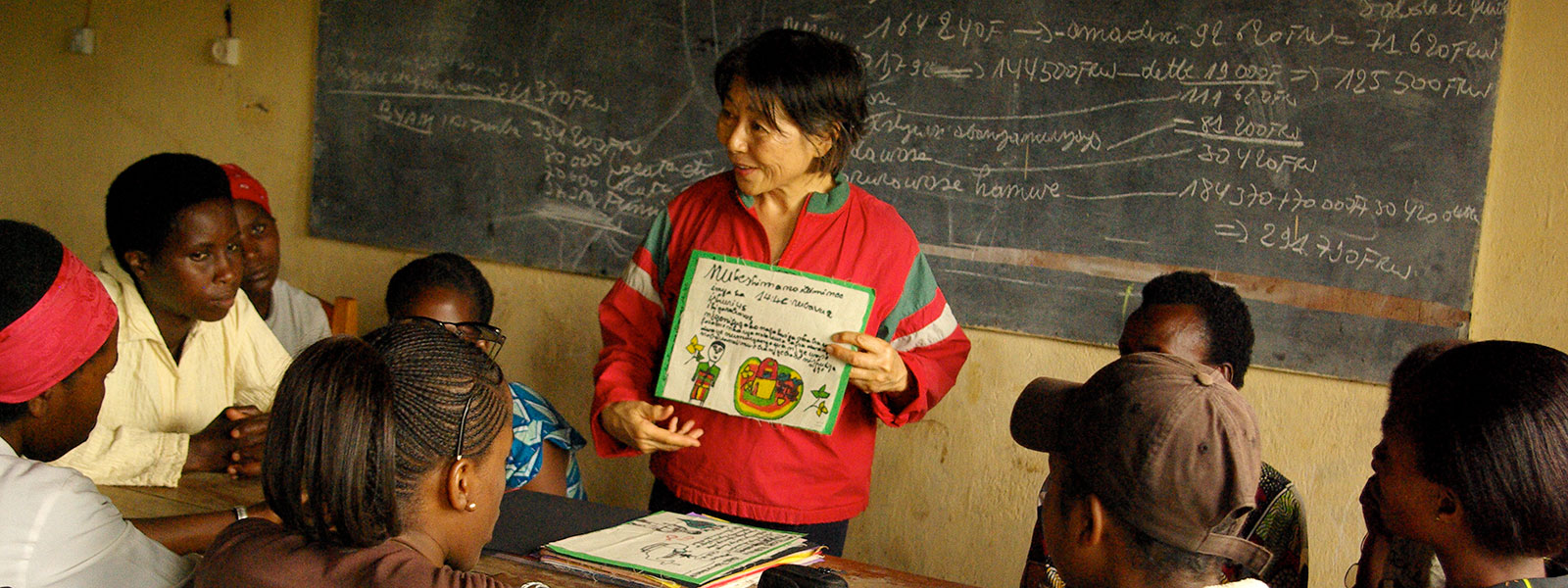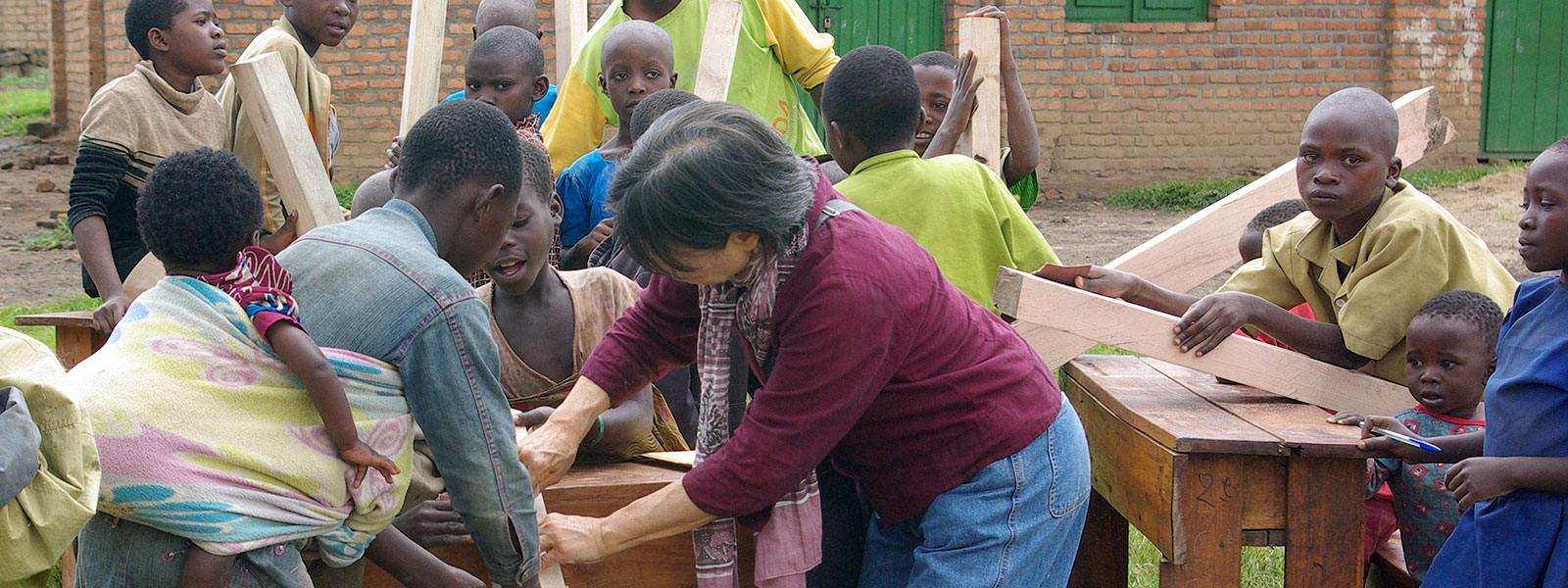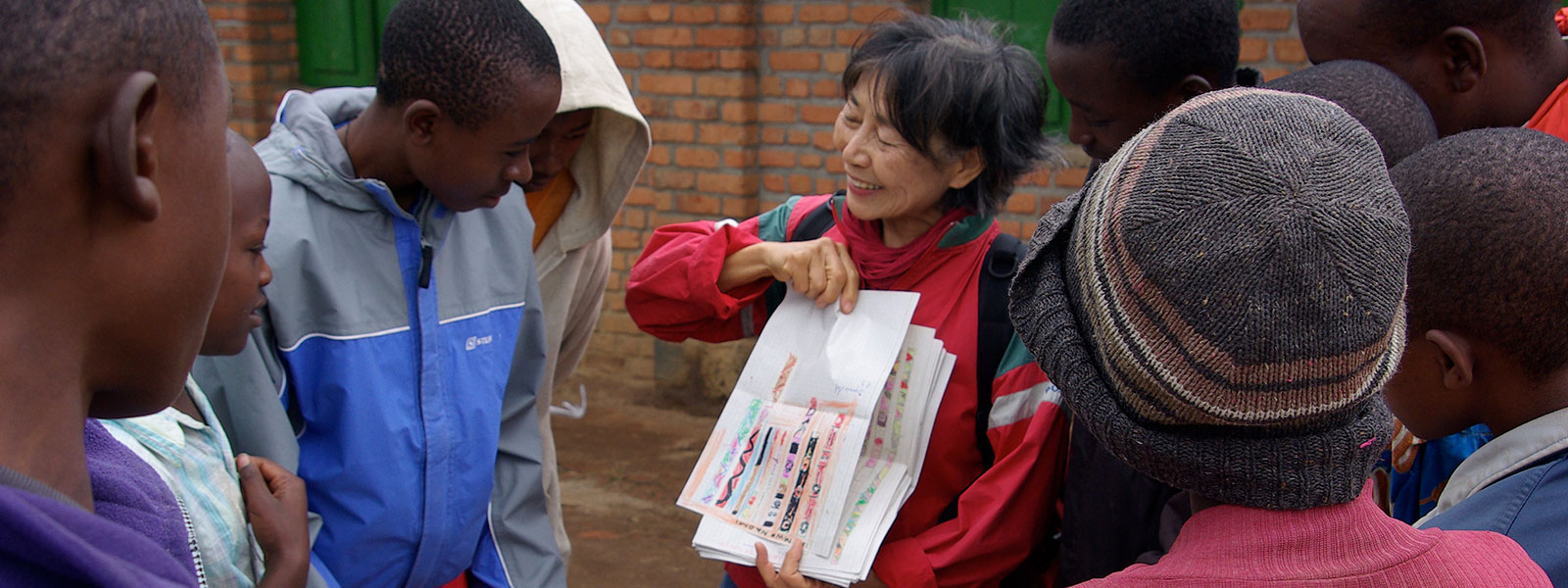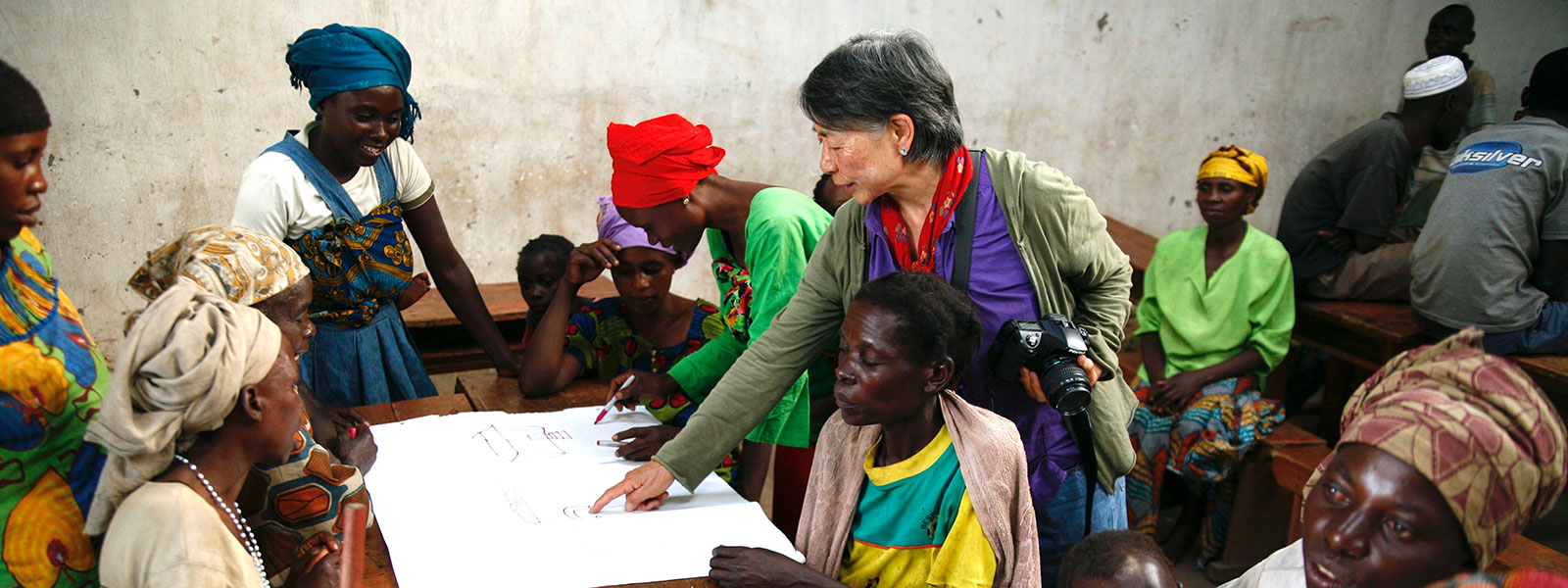Artist As Leader: Lily Yeh
Lily Yeh was an internationally recognized artist as well as a respected professor when in 1986 she was invited by a North Philadelphia community leader to create a piece of public art in an abandoned lot in his neighborhood. That invitation changed her life and eventually the lives of countless residents in neighborhoods from Philadelphia and Milwaukee to communities in Kenya, China and Rwanda.
In the late ’80s, she, with the help of children and adults from an inner-city neighborhood in North Philadelphia, created what came to be known as The Village of Arts and Humanities. It contains a series of parks, gardens and renovated houses that have become a vibrant and cherished community hub. Lily’s work on The Village became an inspiration for creative place-makers around the world and earned her global recognition and dozens of fellowships and awards, including honorary doctorates from Villanova University, Syracuse University and the University of Massachusetts.
After serving for 18 years as the Village’s executive director and lead artist, Lily created Barefoot Artists, an organization that allowed her to bring her practice of building community through the arts to neglected neighborhoods around the world. Among the projects Lily has created with Barefoot Artists are the building of the Genocide Memorial Park in Gisenyi, Rwanda; the transformation of the Dandelion School for migrant children on the outskirts of Beijing from a harsh and bleak old factory into a vibrant campus filled with dazzling murals and mosaics; a series of projects in the Korogocho dump site community outside of Nairobi, Kenya; and several more projects in Balata Refugee Camp in the West Bank.
In this interview with Pier Carlo Talenti, Lily discusses how listening closely to and taking action to follow her inner voice led her down a completely unforeseen artistic path and a new understanding of home, community and belonging.
Choose a question below to begin exploring the interview:
- You’ve talked about being fearful when you were starting [The Village of Arts and Humanities]. How did you lead yourself through that discomfort and how did you find the strength to overcome your trepidation?
- How did you keep the community invested in the park as you were learning how to build it?
- It sounds to me like you’re not comfortable describing yourself as a leader, that you think of yourself as more of a conduit.
- As you know we’re, certainly in this country, living through what feels to me like a very fragile time. How would you like to see artists leading us through these uncertain times?
- If you could go back to 1986 and meet yourself at that time, is there any advice you could give yourself that might have been helpful as you started that part of your journey?
- Epilogue
Pier Carlo: I want to take you back to 1986, when you were first starting to tackle what would become The Village of Arts and Humanities in North Philadelphia. You’ve talked about being fearful when you were starting that project. Not knowing what you were getting yourself into, how did you lead yourself through that discomfort and how did you find the strength to overcome your trepidation?
Lily: All along I never thought of myself as being a leader or of consciously making a decision to go to a broken community and to help the people. That was not in my intention when I started it. I actually started the project not so much to help others but really trying to help myself, on the foot of deficiency.
I actually had a very nice life then. I’d graduated from the graduate school of University of Pennsylvania, Fine Arts Department. I had taught in a couple colleges and universities and at that time was teaching at the Philadelphia Colleges of Art, now known as the University of the Arts. It was a wonderful position, wonderful job working with young students. I was showing at the very prominent Marian Locks Gallery, the best in Philadelphia.
But somehow something was not satisfying me. It actually had been happening for years, but it became more and more prominent. I felt that somehow something essential in my life was missing. I couldn’t put my finger on it, so I started searching for it.
I remember when I was growing up in Taiwan, studying Chinese landscape painting, encountering this very special place that always felt tranquil. My heart was always full of joy, excitement, inspiration. It’s powerful, poignant, but so distilled in its clarity and the serenity. I felt I needed to find that place. I needed to be in contact with this special place that made me feel content, fulfilled, dynamic and serene. The Chinese call it the Dustless World. I said, “Wow, it’s my home. I need to go home!” But it’s not a home in a physical sense; it’s a spiritual home.
Even way before ’86 I was traveling far and wide looking for something, and I was reading a lot and so forth. In ’86, it was just like by chance, I wrote a little grant, and I was invited by the very talented late African American dancer and choreographer Arthur Hall. He had an organization called Ile Ife Black Humanitarian Center in North Philadelphia.
We met — I’d admired him from afar for some time — and he said, “I have an abandoned lot. Would you come and make some art on it?” I was rather naïve and didn’t think too much. I was more prone to action, and everybody was writing proposals. I actually had no idea what it is like to work with children or in African American communities or even to make anything outdoor.
But I was just thinking, “Wow, everybody’s doing it. Why don’t I also try it?” [She laughs.] Just like that! I didn’t think anybody would even pay attention, but I got a little grant, $2,500.00. By the time I went back to that abandoned lot, the city had leveled ten houses, all abandoned houses, leveled them. So I had this huge lot, and I was so puzzled and frightened and had no clue.
I went to talk to the experts, and they said — you know, people who did landscape, outdoor landscape and sculpture and so forth — they said, “Wow, you are an outsider. This is not your community; people won’t welcome you.” Then they said, “Well, kids are going to destroy everything you build.” Then they said, “What you got is a drop in the bucket. You shouldn’t do the project, but you should do a feasibility study and then forget about the project until later.”
I listened to the advice from the experts. As I was drafting the letter, a very clear but fragile, small voice in me said clearly, “If you do not rise to the occasion, the best of you will die and the rest will not amount to anything.” I said, “Well, I don’t want to look at myself in the mirror and down the road say I was a coward.” I said, “Well, even though I don’t know how to do it, maybe I can do something with the children.”
So with that I went in by myself, and then I was saying, “Wow, I have no clue how to even start.” And Arthur Hall advised me. He said, “You need to find JoJo.” Joseph Williams. He lived in a half-abandoned house, half-renovated, next to the abandoned land. He’s a jack of all trades, and he didn’t have a job then. So I tracked him down. After the third effort, I had a chance to talk to him, and he bought into the project.
That was how it started. I didn’t think about helping others. I was just trying to get a hold of myself, finding out who I was as an immigrant Chinese American and what does it mean to be an artist in the vibrant, ever-changing, dynamic, wild art scene in America at that time.
Everything started from a deficit, not having enough, and from my own weaknesses. But lo and behold, life has a way to lead us to our journey when we really strive towards it.
Everything started from a deficit, not having enough, and from my own weaknesses. But lo and behold, life has a way to lead us to our journey when we really strive towards it.
Pier Carlo: How did you keep the community invested in the park as you were learning how to build it?
Lily: I would say, when people would ask me this kind of question, how do I try to build community: I never tried. I never believed that I had the power to build community. That was overestimating my own power.
But what happened, I think, is really that I in my heart am a Taoist. Taoism, Confucianism and Buddhism are the three powerful culture-shaping forces in Chinese civilization. In my heart I am a Taoist because Taoism is about the way of nature. It’s just how nature works. The way I went about it was that I needed to have a grip of who I am to understand the meaning of my existence, and so I went into it and I do it through art, since my training is in the arts.
When children came, it was not in my mind, “Oh, those children who are on the streets where nobody cares for them, I have to do something for them.” Not at all. At the beginning I was afraid of them because I felt the children’s energy can be so wild. But then JoJo was there. They admired JoJo. So they would come. Then we had to mix cement, we had to dig in the ground. The children were so happy. All the things they like, I got it! [She laughs.] Spades and shovels and, what do you call them, dirt and cement and whatever.
It was like a big mud park. They’d just go from one thing to another. They were so happy. In that landscape of so much sadness and brokenness and disappointment and so forth, the children’s laughter sent ripples of joy, signifying a possibility and hope. I didn’t know all that; it was years later, reflecting on the importance of children’s play and participation.
When my friends told me that kids are going to destroy everything you built, I thought, “Well, in that case, we have to engage the children so they won’t destroy the things they built.” The children not only did not destroy them; they became the guardian angels of the humble things that we had created. The children — now every time I go, I will meet some — now they bring their children through the park and show them what they did, participated in when they were six, seven, 11 years old.
I didn’t build it; it built itself. When your platform is open and equal and welcoming and full of encouragement, then I think people want to come and participate.
It is so powerful. I didn’t build it; it built itself. When your platform is open and equal and welcoming and full of encouragement, then I think people want to come and participate. Making art is so fun if we don’t put a value judgment: “Oh you did this, and it looks like that, so you’re good.” If we don’t judge that way and we just say, “Man, you put the mosaic on the column. How wonderful! Oh, this is a wonderful blue, like the sky.” Just simple encouragement. It builds children’s self-esteem, then they bring their friends. Eventually they brought their parents. They brought their schoolteachers to us.
That’s how we grew, not with our efforts but with the positive output in our joint effort. It naturally happened. A lot of the time I say making art in those very sad, desperate places is like lighting the fire in winter’s night. It provides light, warmth, direction, beckoning people to join. It’s like a rock thrown into a pond. It ripples to all directions, gentle ripples.
Pier Carlo: It sounds to me like you’re not comfortable describing yourself as a leader, that you think of yourself as more of a conduit.
Lily: It’s not that I don’t feel comfortable about naming myself a leader. I am absolutely a leader in my vision. I think my method is not so much recruiting others as a leader, but I am a leader setting out bait.
For example, I will get all the things kids like, like seedlings, like wood chips, like water to splash about in, but never from the side of “I’ve come to help you.” We help each other. Through their help, through this kind of work, I found my voice. With deep gratitude I am to the community and the children to trust me and give me the opportunity.
I am absolutely a leader in my vision because what is essential — I’m an artist — I go for that. I know through many, many failures, it is not just, “Whatever you do, you put it up and you call it art.” It’s like alchemy; I call it alchemy. You have to keep on distilling it. You trim it, you make the proportion right, the color right, the relationship right, level by level. Through many failed efforts I learned this. Finally, when it is the right visual image, it has the power to transform the space it is in and the participants, the individual and communities.
I am absolutely dedicated to realizing my vision, and in that I don’t compromise and I don’t negotiate. I need to reach that pinnacle point, the best I can deliver. But in the process of delivering that vision, it’s completely open and welcoming. People come, people go, always according to their interests, their need and their own fulfillment.
Sometimes I think it’s like I’m a train conductor. In the beginning it was just me. But I have a sense of where I’m going. I’m trying to find that place, that sacred place, that sense of belonging. It doesn’t matter where I am in the world, I feel centered; I belong in the current time and space. That place, I know I’m driving a train towards that. Then people see, “Wow, this train, maybe I can take a ride!” People get on, and then they say. “Wow, it’s enough; I need to get off.” I say, “Welcome, have a good day,” and other people ride on.
Community-building is very complicated. It’s always three steps forward, two steps backward. But if I know the direction I’m going and go there steadfastly and without compromising, eventually I will reach it and deliver my vision. Then I feel fulfilled.
The broken and ignored places, the abandoned railroad tracks, all those places are our new frontier. ... Through embracing the darkness, it can be transformed to luminosity, togetherness and harmony.
If people ask me for advice through my experience, I will just say that the broken and ignored places, the abandoned railroad tracks, all those places are our new frontier. In the disenfranchised communities, there was enormous hidden wisdom and talents and capabilities. We have to take off our colored glasses, and we have to look with new eyes to see the hidden jewels for us to discover and to embrace. Through embracing the darkness, it can be transformed to luminosity, togetherness and harmony.
Pier Carlo: As you know we’re, certainly in this country, living through what feels to me like a very fragile time. It feels like there are a lot of broken places in America today. How would you like to see artists leading us through these uncertain times?
Lily: Continue to deliver art in whatever way. Artists and young people, many, many have already been doing it. For example. the climate crisis. It’s existential for not only human beings but all living beings, for our planet, and it is the young who are leading us in all kinds of creative and bold actions. Also artists, I see how artists are trying to bring people together. For example, you sing in all different, far-out places, but online we can sing together. Or you can stand on your balcony; you can clap and show your gratitude.
My thing is, don’t get caught in the despair, in the lack of power of individuals. Individuals are so powerful. Use our imagination, and then do whatever that our hearts call us to act on. It could be protest, it could be against a pipeline, it could be pots and pans and making music and whatever. It could be painting a sidewalk, whatever, just taking action that is generated in well-being for all, based on the kindness and openness and welcome and joining together and creative energy and led by compassion and fairness. That will lead us to light and hope.
Pier Carlo: Finally if you could go back to 1986 and meet yourself at that time, is there any advice you could give yourself that might have been helpful as you started that part of your journey?
Lily: Oh, yes. Many things! [She laughs.] The first thing is structurally. Eventually The Village from the abandoned lot — very open and equal — slowly became an organization. The society basically is hierarchical. We trust people who have very prominent degrees. The more Ivy League, the more expensive, elite and exclusive background you come from, the better. “You are equipped to lead us,” you know?
At that time, my goodness, in a way I was thrust into the leadership position. I had no clue. And then fortunately I had a strong sense of the inner power which is irresistible, which is powerful, which I trusted and which led me on.
I think I let the society shape the shape of our organization. It became, “You have a director, you have different branches, you have directors,” and we were asked to measure our success by the standards of the commercial: “How many people have come through your program? How many people graduated? What’s the impact? Are you following them?” and blah, blah, blah. That wasted a lot of our energy, and also it led us on the wrong track, the hierarchy.
I had tried to build a completely equal, open, accessible space, and that was partitioned. Looking back I wouldn’t allow that. Barefoot Artists is totally different. It’s avant-garde and 21st century, very flexible and lean and powerful. It’s almost like tumbleweeds. When there’s no resources, we’re skeleton existence. But when we do have resources, suddenly we boom into a forest, marching to realize and deliver our vision.
That’s how we’re helping the fourth village so far away in Rwanda. Then in South Sudan, collaborating with my colleague Monica Gaspari, who was working at Solidarity Teaching Training College in Yambio, we empowered and guided 75 elementary school teachers from all over the country in transforming the rather characterless and bland campus into an environment full of color and vibrancy. The teachers were totally delighted and inspired. They’re going to bring this skill into their own villages. This is how you propagate. It’s nature’s way of propagating in the most effortless but effective and well-organized way but not the way we often imagine it.
Our sponsors often advise us, “Oh you should do this, you should do that, you have to do your finances this way,” and so forth. Eventually the management became burdensome for me. I am an artist. It’s like a musician. I had a beautiful instrument, the Village of Arts and Humanity. It’s a wonderful organization, but at one point after 17, 18 years, I realized that I spent most of the time tuning the instrument and rarely got to play it. Then I said, “I can’t. I have to return to the frontline, the frontline where I can create freely and find the way that is most efficient, most direct to deliver my mission, my vision.” That is why I left and formed the new organization called Barefoot Artists.
Epilogue
Lily Yeh provides a great example of the unexpected opportunities and successes that come in life if we are only willing to look out for and follow them. Takeaways from our conversation with Lily include:
- Find your flow. Lily finds it through Taoism and art. Remain curious as to when you are most connected to your truest gifts and develop the tools to revisit that state whenever you need.
- Have courage. The biggest limitation for artist leaders tends to be fear and limiting beliefs. Recognize when the voice in your head is louder than the drive in your heart, and then turn the volume down.
- Recognize community and informal leaders. To lead change it is useful to recognize who is respected and listened to. Enrolling those influencers is the first half of the process to success.
- Implement your vision. It’s not enough to know your vision. You have to effectively communicate the vision and let others take over driving the bus after you step back.
- Let compassion and fairness lead. The world is in a precarious place at this moment in history. Artist leaders are needed now more than ever to steer our ethical and moral compass towards the values that make humans humane.










